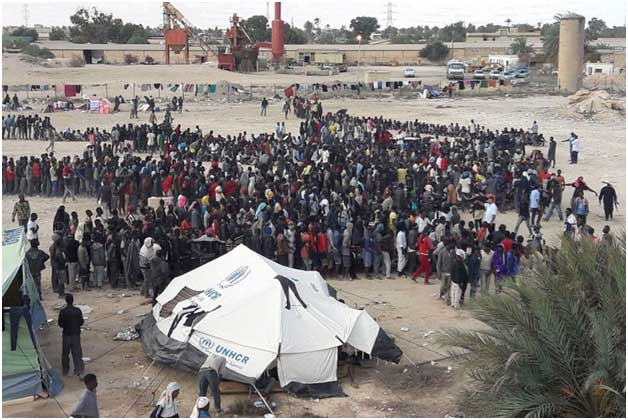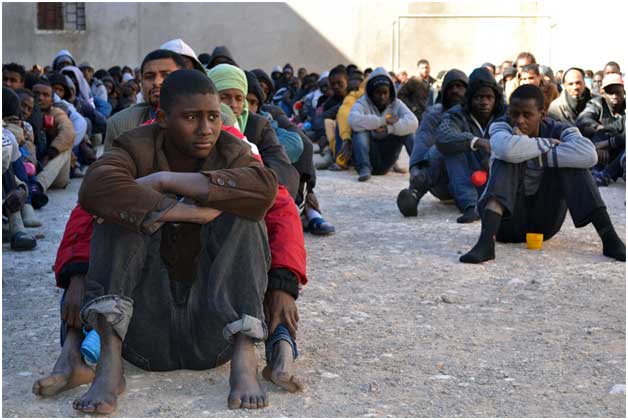Migrants, Militias & the Mediterranean Sea

BERLIN, Jul 11 (IPS) - Marco Funk is a Policy Officer at the Friedrich-Ebert-Stiftung EU Office, where he is responsible for the foundation's Brussels-based activities related to EU migration and home affairs. He previously worked as a Policy Analyst for the European Policy Centre, where he focused on EU migration and asylum policy.
When the Italian police recently arrested Carola Rackete, captain of the Sea-Watch 3 search and rescue vessel, the Central Mediterranean Sea suddenly entered the international limelight once again.
Media coverage of the most dangerous migration route in the world had previously been quite muted everywhere except Italy, where for months Interior Minister Matteo Salvini used every opportunity to publicly lambast the German NGO's activities – despite low numbers of arrivals.
In fact, Captain Rackete became Salvini's (and increasingly his voters') enemy of choice well before her arrest. At the same time, she became a hero to those who support rescuing migrants at sea.
Yet despite the uproar, the row about NGO rescue ships represents only a small part of the complex geopolitical puzzle that drives irregular migration along this route. Carola Rackete's arrest will have a very limited impact on the overall situation.
In order to truly understand what's going on in the Central Mediterranean, one must retrace migrants' steps all the way back to their countries of origin – often in sub-Saharan Africa, the Middle East or even South Asia.
Some are refugees as defined by the 1951 Refugee Convention, others are not, but practically all of them have good reasons to leave their homes. This mixed migration flow typically crosses several countries before entering Libya, the main gateway to Europe.
EU efforts in Libya since the fall of Gaddafi have focused heavily on curbing migration to Europe. Some activities bend or even violate international law to keep migrants at bay.
African migrants crossing the Sahara Desert face dangers as severe as those at sea, with an uncounted death toll possibly far greater than that in the Mediterranean. Once migrants enter Libya, they find themselves in a comparatively wealthy country – Libya holds Africa's largest oil reserves.
However, it is also a war-torn country in political disarray since the fall of ex-dictator Muammar Gaddafi in 2011.

The Libyan situation
At the moment, there are over 660,000 migrants in Libya according to estimates by the International Organization for Migration. Their conditions vary according to nationality and location.
Some long-term residents from North Africa or the Middle East are quite happy to stay in Libya, while more recent arrivals from sub-Saharan countries often face severe discrimination, exploitation and abuse.
As Libya never signed the 1951 Refugee Convention, refugees have no legal status in the country and cannot seek international protection there. In fact, undocumented migrants in Libya can be arrested and imprisoned at any time.
Local militias, acting as police in areas they control, also run detention centres where they extort money from migrants or sell those who cannot pay to smugglers and human traffickers.
Some of these same militia members are on government payrolls and are supported directly or indirectly by EU missions seeking to train and equip border police and coast guard officials.
EU efforts in Libya since the fall of Gaddafi have focused heavily on curbing migration to Europe. Some activities bend or even violate international law to keep migrants at bay.
But there's no way to address the issue effectively without settling the ongoing power struggle between the Government of National Accord (GNA) headed by Prime Minister Fayez al-Sarraj and rival Khalifa Haftar, commander of the Libyan National Army (LNA), based in the east of the country.
While the internationally recognised GNA is officially supported by the EU and Italy in particular, its actual control of Libyan territory is limited to Tripoli and some areas of Western Libya controlled by allied militias.
Meanwhile, France backs the LNA, which controls the east and parts of the south of the country either directly or by proxy through local militias. Haftar launched an attack on Tripoli in April 2019, just days before a planned national conference to organise presidential and parliamentary elections to help solve the political crisis in Libya.
The conflict is currently at a stalemate, with Haftar's forces fighting against the GNA on the outskirts of Tripoli.
The EU needs a common strategy
The EU's split position isn't just awkward but indeed counterproductive in finding a solution to the conflict, and by extension the migratory situation as well. Italy and France should agree on a common strategy and facilitate a peace deal between the GNA and the LNA by using their respective influence on each side of the conflict.
The EU could then step up its capacity building work, help professionalise Libya's security sector, strengthen civil society and invest in projects that unlock Libya's economic potential. Stability and prosperity in Libya would significantly reduce migratory pressure to Europe by making it safer and more attractive as a destination country for labour migrants – as it was before the revolution.
As the European Parliament and the European Commission start their new terms this year, migration should be back at the top of their agendas.
Stabilising Libya will certainly take time and may not even be possible because the conflict is so complex and involves a multitude of internal and external non-EU actors. The EU must therefore simultaneously work towards a sustainable search and rescue, reception and relocation mechanism for those who manage to leave Libya.
Italy's decision to close its ports and criminalise NGOs attempting to bring rescued migrants to shore is certainly deplorable. Yet it's also understandable given the lack of solidarity other EU member states have demonstrated long before Salvini was elected to government.
As a result, Malta now feels the cold shoulder of northern and eastern European indifference as it receives more and more arrivals diverted from Italy. The current practice of ad-hoc, case-by-case relocations for each boatload of migrants rejected by the Italian authorities is simply not sustainable.
Solving the question of asylum seeker relocation within the EU may even be more difficult than achieving peace in Libya, as the never-ending standstill in negotiations between the European Parliament and Council on the reform of the Dublin Regulation demonstrates.
But it must be done. There's no other way to handle the arrival of migrants seeking asylum in Europe. The alternative is a political backlash in frontline member states that threatens the entire EU project.
As the European Parliament and the European Commission start their new terms this year, migration should be back at the top of their agendas. However, in contrast to the last terms, they should approach irregular migration through the Central Mediterranean not as an isolated issue, but rather as one element in an interlinked set of challenges requiring integrated policy responses.
Only then does the EU stand a chance at finding sustainable solutions that can withstand the inevitable migratory pressure facing Europe in the future.
This article first appeared in International Politics and Society published by the International Political Analysis Unit of the Friedrich-Ebert-Stiftung, Hiroshimastrasse 28, D-10785 Berlin.
© Inter Press Service (2019) — All Rights Reserved. Original source: Inter Press Service
 Global Issues
Global Issues